
- Understanding the Determinants of ICC Involvement: Legal Mandate and Power Politics – with Alyssa K. Prorok and Benjamin Appel. (2024). International Studies Quarterly.
-
Increasingly in recent years, scholarship has reached a consensus that armed groups' decision to kill civilians is strategic in nature. However, most examinations of this choice (and its consequences) assume a simple, dyadic environment where the main conflict is between a government and a unified opposition. Yet, we know empirically that civil wars are more complicated than this, often involving three or more actors. We investigate the strategic incentives for civilian victimization in a complex multi-actor conflict environment using an innovative agent based model. We find that, irrespective of the overall intensity of conflict, more dense strategic environments -- where conflict between any two actors is more likely -- lead to a markedly higher tendency to target civilians by all groups. We empirically test this hypothesis in multi-actor civil wars using ACLED to generate conflict specific measures of both intensity and network density. Preliminary empirical analysis is supportive of our findings that a more dense strategic environment is associated with a higher level of violence against the civilian population.
-

- Networks of Violence and Civilian Targeting During Civil War – with Cassy Dorff & Max Gallop. (2023). British Journal of Political Science.
-
Increasingly in recent years, scholarship has reached a consensus that armed groups' decision to kill civilians is strategic in nature. However, most examinations of this choice (and its consequences) assume a simple, dyadic environment where the main conflict is between a government and a unified opposition. Yet, we know empirically that civil wars are more complicated than this, often involving three or more actors. We investigate the strategic incentives for civilian victimization in a complex multi-actor conflict environment using an innovative agent based model. We find that, irrespective of the overall intensity of conflict, more dense strategic environments -- where conflict between any two actors is more likely -- lead to a markedly higher tendency to target civilians by all groups. We empirically test this hypothesis in multi-actor civil wars using ACLED to generate conflict specific measures of both intensity and network density. Preliminary empirical analysis is supportive of our findings that a more dense strategic environment is associated with a higher level of violence against the civilian population.
-
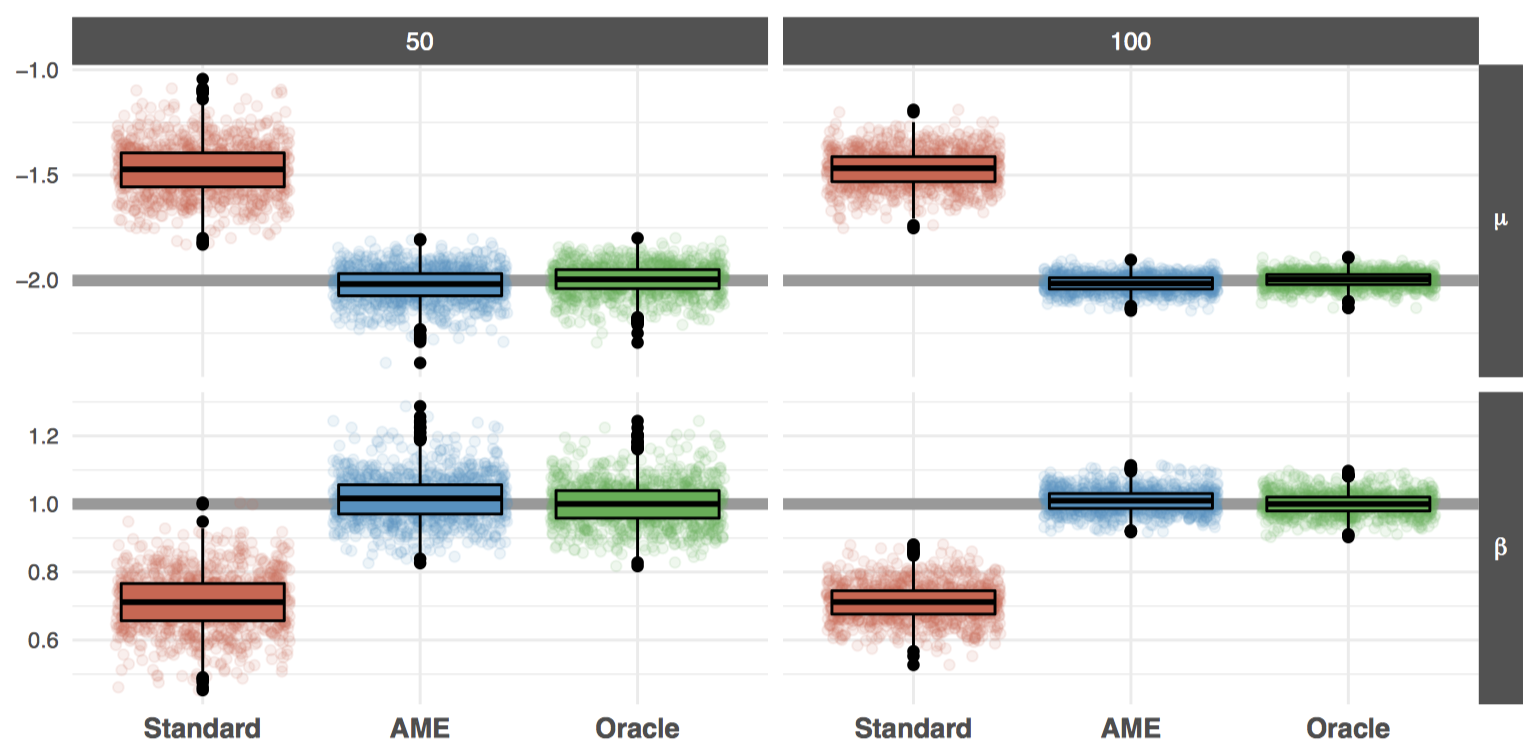
- Taking Dyads Seriously – with Cassy Dorff, Max Gallop, Margaret Foster, Howard Liu, Juan Tellez, & Michael D. Ward. (2022). Political Science Research & Methods.
-
Much of international relations scholarship concerns dyads. Dyadic hypotheses and especially dyadic data abound. Standard modeling approaches fail to adequately capture the data generating process behind dyadic events and processes. As a result, they suffer from biased coefficients and poorly calibrated standard errors. We introduce a regression-based approach, the Additive and Multiplicative Effects (AME) model, that better accounts for the inherent dependencies in dyadic data. First, we conduct a simulation to highlight how the model captures dependencies and show that accounting for these processes improves our ability to conduct inference on dyadic data. Second, we compare the AME model to approaches used in three prominent studies from recent international relations scholarship. For each study, we find that compared to AME, the modeling approach used performs notably worse at capturing the data generating process. Further, conventional methods misstate the effect of key variables and the uncertainty in these effects. Finally, AME dominates standard approaches in terms of out-of-sample fit. In sum, our work shows the consequences of failing to take the dependencies inherent to dyadic data seriously. Most importantly, by better modeling the data generating process underlying political phenomena, the AME framework improves scholars’ ability to conduct inferential analyses.
-
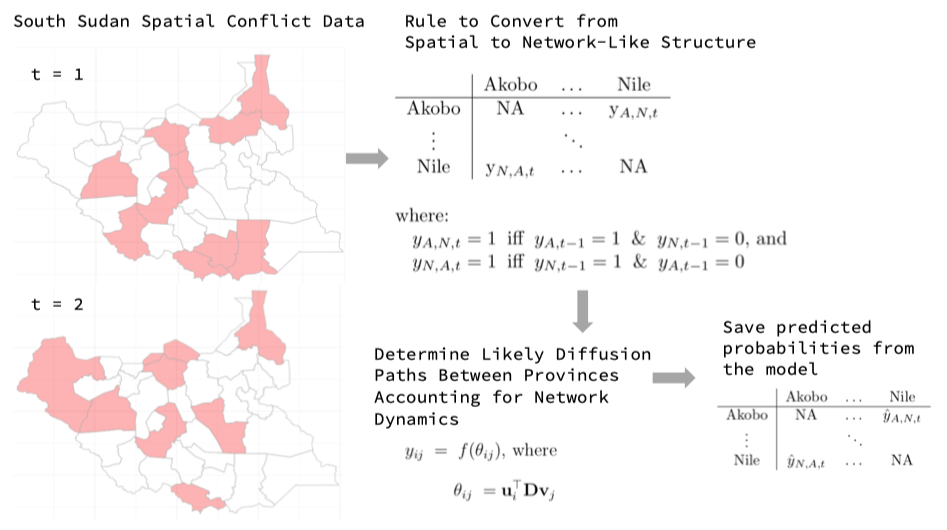
- [W]hat lies beneath: Using Latent Networks to Improve Spatial Predictions – with Cassy Dorff and Max Gallop. (2022). International Studies Quarterly.
-
Spatial interdependencies commonly drive the spread of violence in civil conflict. To address such interdependence, scholars often use spatial lags to model the diffusion of violence, but this requires an explicit operationalization of the connectivity matrices that represent the spread of conflict. Unfortunately, in many cases, there are multiple competing processes that facilitate the spread of violence making it difficult to identify the true data-generating process. We show how a network driven methodology can allow us to account for the spread of violence, even in the cases where we cannot directly measure the factors driving diffusion. To do so, we estimate a latent connectivity matrix that captures a variety of possible diffusion patterns. We use this procedure to study intrastate conflict in eight conflict-prone countries and show how our framework enables substantially better predictive performance than canonical spatial lag measures. We also investigate the circumstances under which canonical spatial lags suffice, and those under which this network technique is beneficial.
-
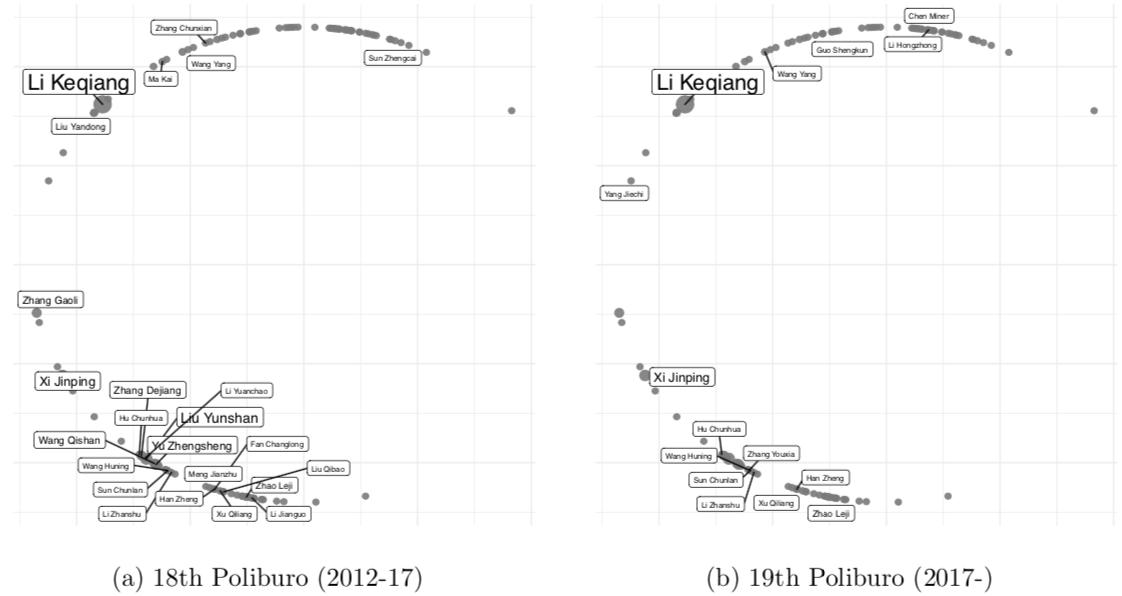
- Who Are in Charge, Who Do I Work With, and Who Are My Friends: A Latent Space Approach to Understanding Elite Coappearances in China – with Narisong Huhe & Max Gallop. (2021). Social Networks.
-
How ruling elite arrange and maintain their power-sharing is key to our understanding of authoritarian politics. We propose a latent space framework to systematically analyze the dynamics of elite power-sharing in authoritarian regimes. We also introduce a novel dataset tracking appearances of elite Chinese Community Party (CCP) members at political events. Our new framework and data allow us to disentangle three key aspects of CCP elite power-sharing: (1) who are in charge, (2) who do I work with, and (3) who are my friends. Using a latent factor network analysis of approximately 10,000 appearance records of over 200 top CCP elites from 2013 to 2017, we empirically assess these three questions by computing elites' total appearances, dyadic coappearances, and their distance in a latent social space. We test how well these three indicators fare at predicting elites' appointments to the leading small groups (LSGs) of the CCP Central Committee and the Central Government, and from that analysis are able to highlight the need to account for the indirect ties elites share.
-

- A Network Approach to Measuring State Preferences – with Max Gallop. (2021). Network Science.
-
State preferences play an important, yet under discussed role in international politics. This is in large part because actually observing and measuring these preferences is impossible. In general, scholars have tried to infer preferences using either UN voting or alliance behavior. The two most notable measures of state preferences that have flowed from this research area are ideal point (Bailey et al., 2015) and S Scores (Signorino & Ritter, 1999). The basis of both these models is a spatial weighting scheme that has proven useful but discounts higher-order effects that might be present in relational data structures such as UN voting and alliances. We begin by arguing that both alliances and UN voting are simply examples of the multiple layers upon which states interact with one another. To estimate a measure of state preferences from this multilayer structure, we introduce a latent factor model that provides a reduced-rank approximation of the main patterns across the layers. Our new measure of preferences plausibly describes important state relations, and yields important insights on the relationship between preferences, democracy, and international conflict. Most importantly, a model of conflict that uses this measure of state preferences decisively outperforms models using extant measures when it comes to predicting conflict in an out of sample context.
-
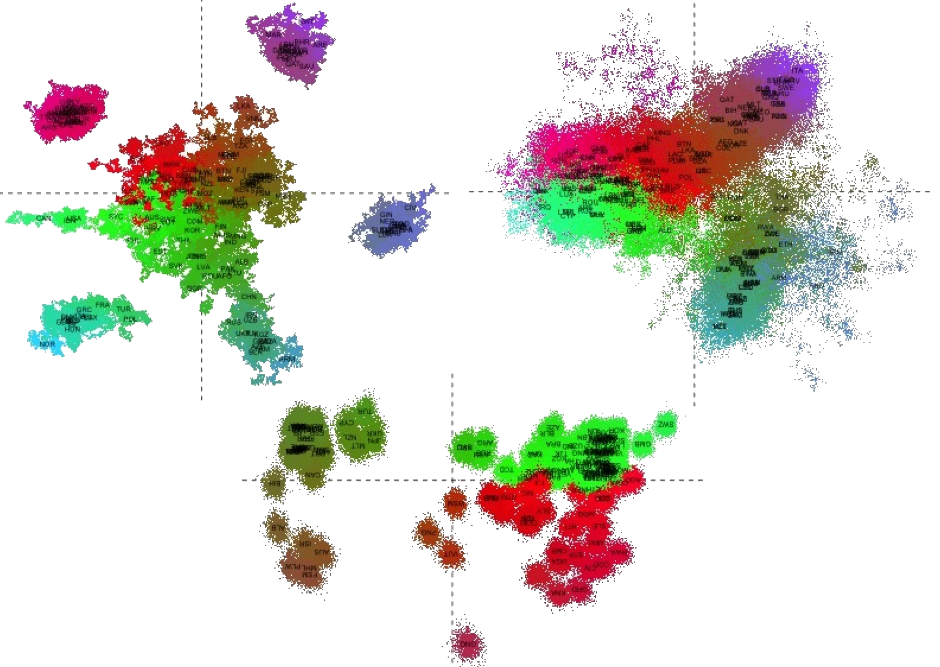
- Keeping Friends Close, but Enemies Closer: Foreign Aid Responses to Natural Disasters – with Cindy Cheng. (2021). British Journal of Political Science.
-
Despite a robust body of evidence that suggests that aid donors are largely motivated by strategic considerations when dispensing aid, anecdotal evidence suggests that countries often receive substantial humanitarian aid following natural disasters, even from strategic opponents. In this paper, we square this seeming incongruity by arguing that natural disasters can serve to, at least temporarily, emphasize the humanitarian, as opposed to the political or economic, aspects of a bilateral relationship. We argue that natural disaster severity increases the likelihood of donors giving humanitarian aid to strategic adversaries in the short term. However, we find that in the long-term, donors are still more likely to pursue strategic self-interest by increasing civil society aid to strategic adversaries following a natural disaster. We test our findings using a new measure of strategic interest which we argue improves upon existing measures by accounting for third-order dependencies in dyadic data. Our findings suggest that social context matters in short-term humanitarian aid allocation. They also have important implications for the future of foreign aid allocations more generally, as the number of natural disasters is likely to rise, not fall, with changing climate conditions.
-
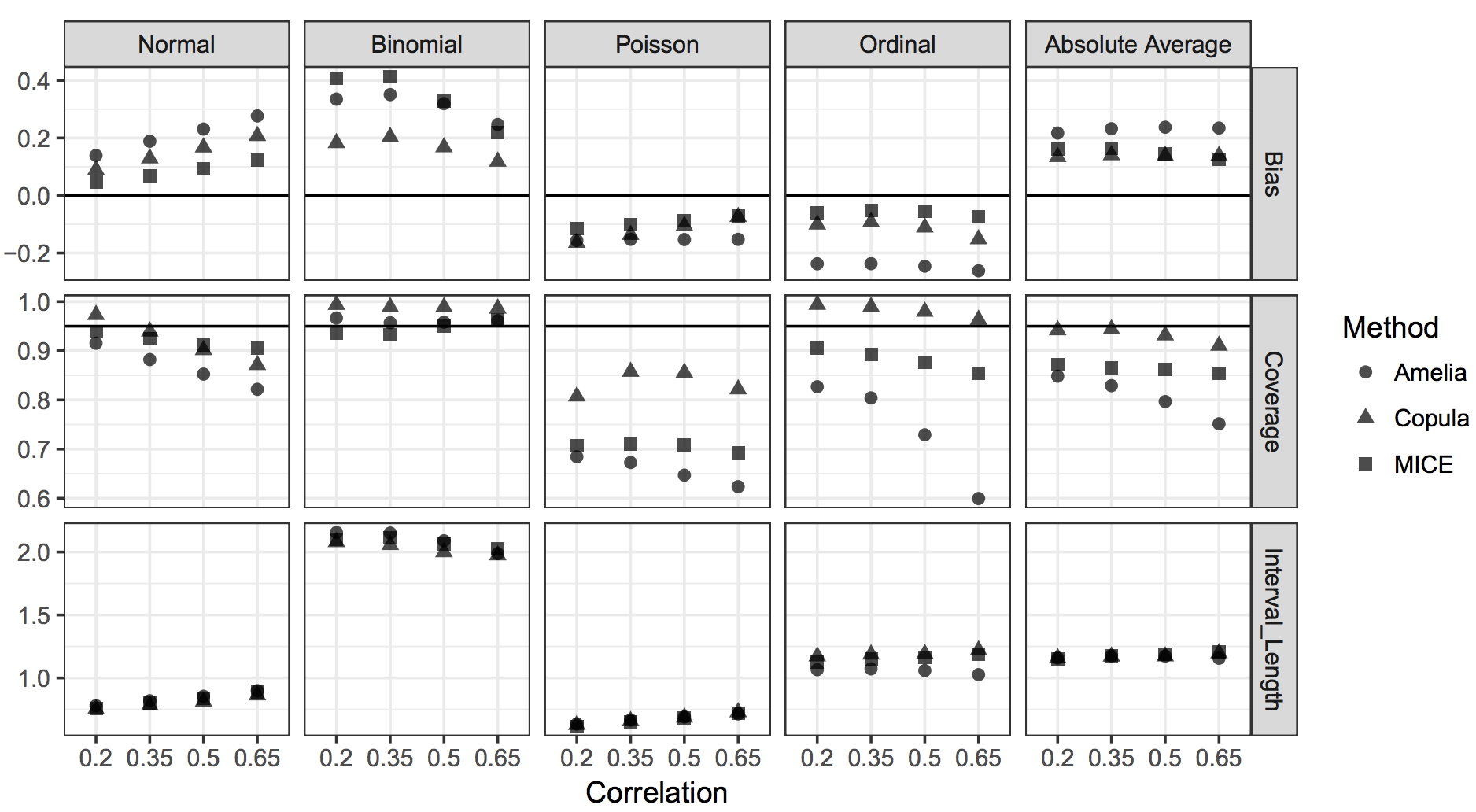
- Multiple Imputation Using Gaussian Copulas – with Florian Hollenbach, Iavor Bojinov, Nils W. Metternich, Michael D. Ward, and Alexander Volfovsky. (2021). Sociological Methods & Research.
-
Missing observations are pervasive throughout empirical research, especially in the social sciences. Despite multiple approaches to dealing adequately with missing data, many scholars still fail to address this vital issue. In this paper, we present a simple-to-use method for generating multiple imputations using a Gaussian copula. The Gaussian copula for multiple imputation Hoff (2007) allows scholars to attain estimation results that have good coverage and small bias. The use of copulas to model the dependence among variables will enable researchers to construct valid joint distributions of the data, even without knowledge of the actual underlying marginal distributions. Multiple imputations are then generated by drawing observations from the resulting posterior joint distribution and replacing the missing values. Using simulated and observational data from published social science research, we compare imputation via Gaussian copulas with two other widely used imputation methods: MICE and Amelia II. Our results suggest that the Gaussian copula approach has a slightly smaller bias, higher coverage rates, and narrower confidence intervals compared to the other methods. This is especially true when the variables with missing data are not normally distributed. These results, combined with theoretical guarantees and ease-of-use suggest that the approach examined provides an attractive alternative for applied researchers undertaking multiple imputations.
-
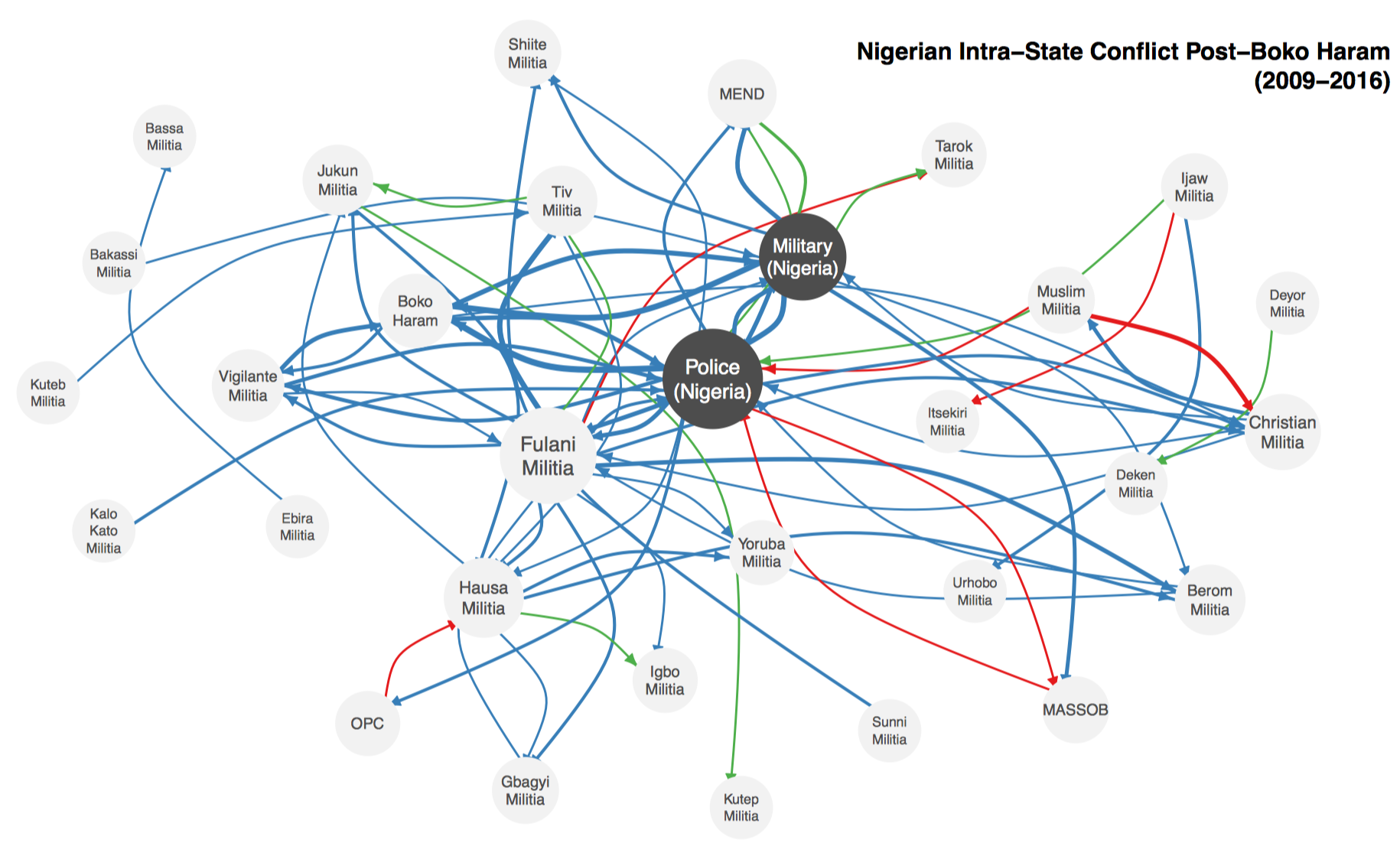
- Networks of Violence: Predicting Conflict in Nigeria – with Cassy Dorff and Max Gallop. (2020). Journal of Politics.
-
Canonical studies of civil war examine the conditions that favor conflict across the globe. While predicting the onset of intrastate war has seen great progress, analysis on the occurrence of battles between actors remains obscure. Despite growing interest in the logic of rebel group fighting, empirical assessment of these relationships is underdeveloped. We unmask the interdependent dynamics of civil conflict by conceptualizing actors and battles as nodes and ties in a network. We examine how these relationships change over time and how their evolution in one time period enables precise prediction of conflict in future periods. Our network approach yields theoretical implications for understanding how the entrance of particularly aggressive actors can decisively alter the trajectory of civil conflict.
-
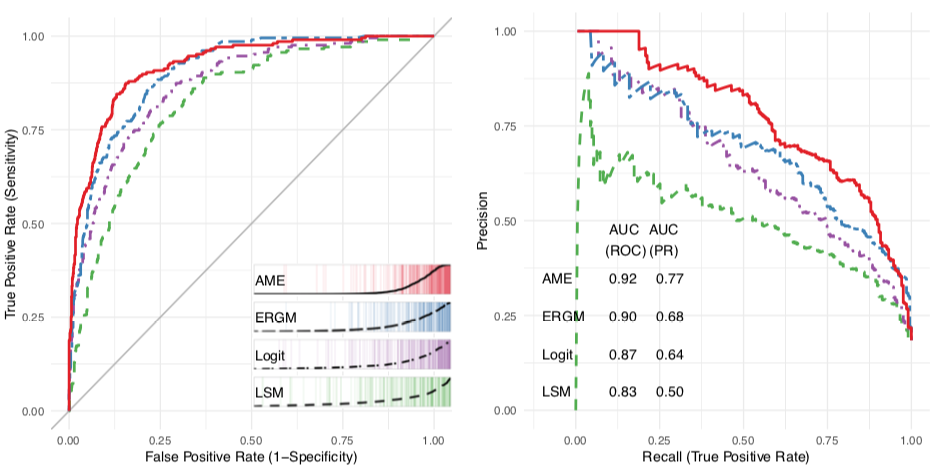
- Inferential Approaches for Network Analysis: AMEN for Latent Factor Models – with Peter D. Hoff and Michael D. Ward. (2019). Political Analysis.
-
We introduce a Bayesian approach to conduct inferential analyses on dyadic data while accounting for interdependencies between observations through a set of additive and multiplicative effects (AME). The AME model is built on a generalized linear modeling framework and is thus flexible enough to be applied to a variety of contexts. We contrast the AME model to two prominent approaches in the literature: the latent space model (LSM) and the exponential random graph model (ERGM). Relative to these approaches, we show that the AME approach is a) to be easy to implement; b) interpretable in a general linear model framework; c) computationally straightforward; d) not prone to degeneracy; e) captures 1st, 2nd, and 3rd order network dependencies; and f) notably outperforms ERGMs and LSMs on a variety of metrics and in an out-of-sample context. In summary, AME offers a straightforward way to undertake nuanced, principled inferential network analysis for a wide range of social science questions.
-
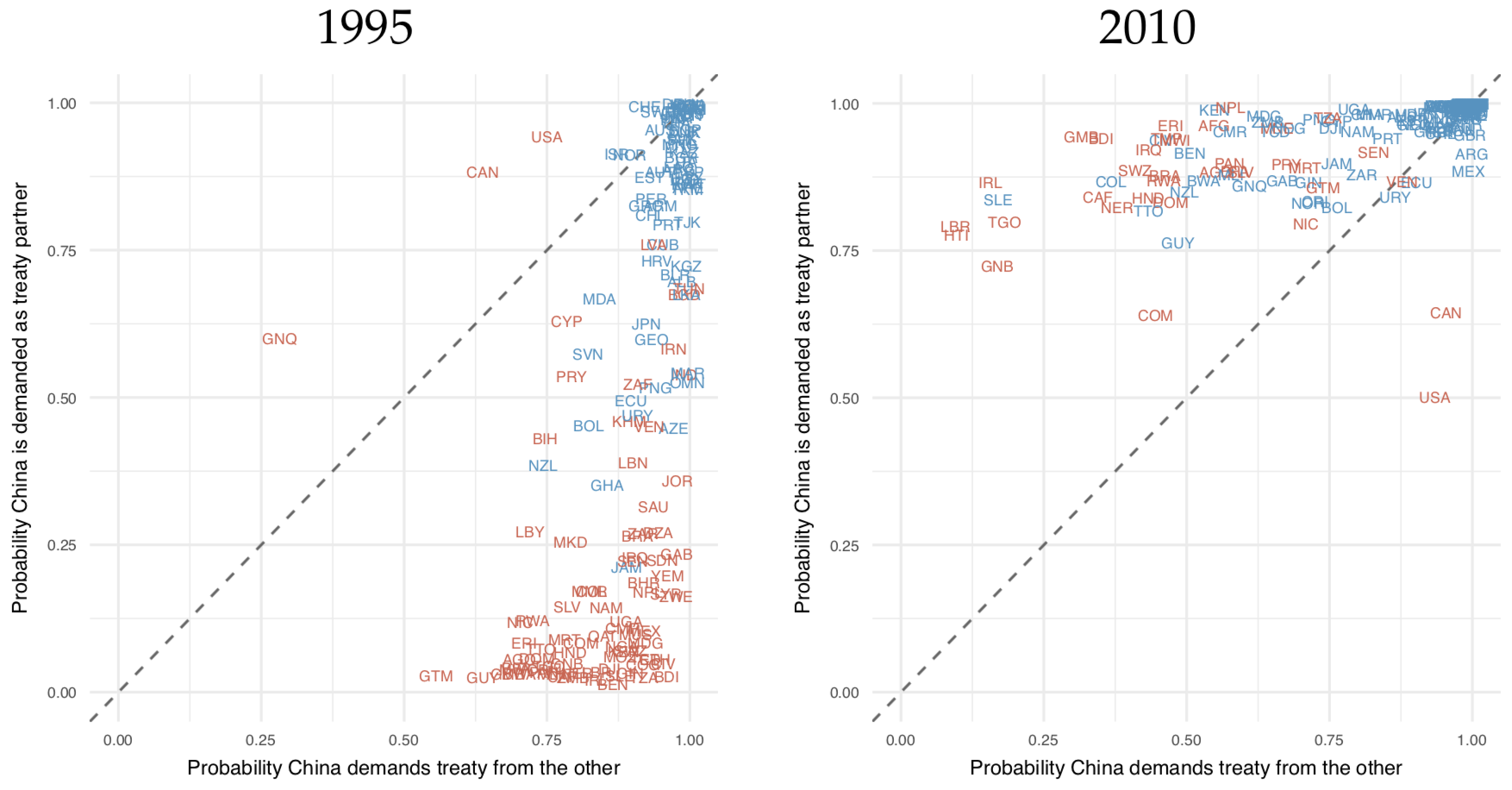
- Modeling Asymmetric Relationships from Symmetric Networks – with Arturas Rozenas and John Ahlquist. (2019). Political Analysis.
-
Many relationships requiring mutual agreement between pairs of actors produce observable networks that are symmetric and undirected. Nevertheless the unobserved, asymmetric network is often of primary scientific interest. We propose a method that probabilistically reconstructs the unobserved, asymmetric network from the observed, symmetric graph using a regression-based framework that allows for inference on predictors of actors' decisions. We apply this model to the bilateral investment treaty network. Our approach extracts politically relevant information about the network structure that is inaccessible to alternative approaches and has superior predictive performance.
-
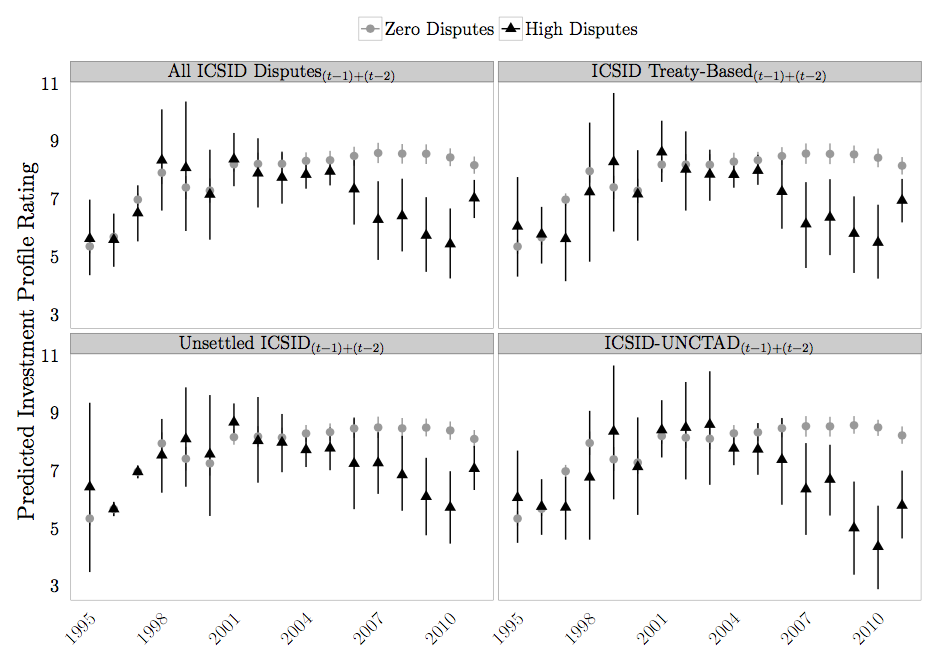
- The Reputational Impact of Investor-State Disputes – with Karen L. Remmer. (2018). International Interactions.
-
To what extent do alleged violations of international commitments damage state reputation? This paper explores this question with specific reference to investor-state disputes arising under the protection of international investment agreements. Its main contributions are threefold. First, building on the political institutions literature, the study places the theoretical importance of information about the rules of the game and the actions of the participants at the center of analysis. Second, in contrast to prior empirical research, the study systematically analyzes the costs of state involvement in investment treaty arbitration by examining all known disputes. Third, the study addresses the impact of investment disputes on both foreign investment flows and state reputational rankings. We show that the consequences of investment disputes vary with the transparency of the investor-state dispute settlement process. The central implication of these findings for the broader body of literature on international institutions is that reputational mechanisms for effective treaty enforcement cannot be taken as given but instead need to be explored on the basis of a nuanced approach that addresses the pivotal issues of institutional design and information costs.
-

- Splitting It Up: The spduration Split-Population Duration Regression Package for Time-Varying Covariates – with Andreas Beger, Daniel Hill, Nils Metternich, and Michael D. Ward (2017). R Journal.
-
We present an implementation of split-population duration regression in the spduration (Beger et al., 2017) package for R that allows for time-varying covariates. The statistical model accounts for units that are immune to a certain outcome and are not part of the duration process the researcher is primarily interested in. We provide insights for when immune units exist, that can significantly increase the predictive performance compared to standard duration models. The package includes estimation and several post-estimation methods for split-population Weibull and log-logistic models. We provide an empirical application to data on military coups.
-
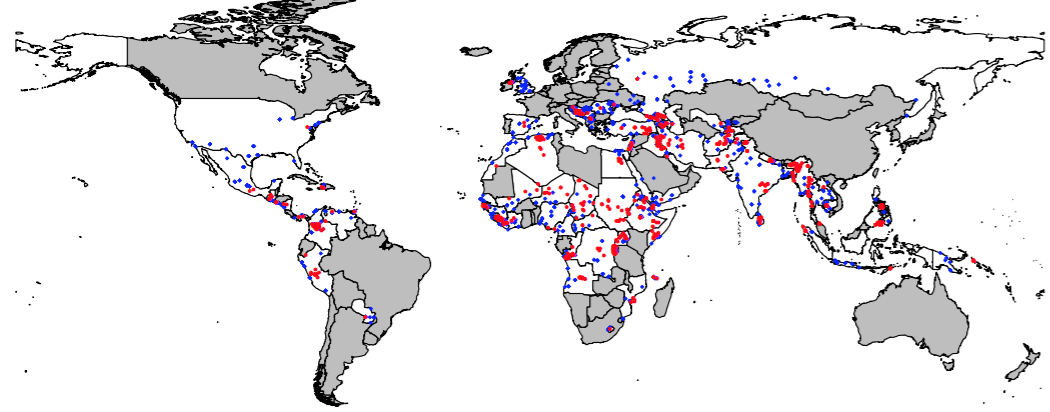
- Enemy at the Gates: Variation in Economic Growth from Civil Conflict – with Benjamin J. Radford (2017). Journal of Conflict Resolution.
-
There has been much disagreement about the relationship between civil wars and state economic performance. While civil war is often associated with poor economic performance, some states have managed robust growth despite periods of domestic armed conflict. We find this disagreement results from not accounting for the spatial distribution of conflict within a country. A robust literature in economics stresses the role major cities play in economic growth. We hypothesize that the economic impact of civil conflict is contingent on the conflict's location relative to major urban centers within a state. We use subnational data on the location of conflict relative to urban areas to test the impact of domestic conflict on annual GDP growth. In doing so, we bridge the economic development literature on the importance of cities with extant literature on the effect of armed conflict to provide a novel explanation for the paradox of high macroeconomic growth in conflict ridden countries.
-
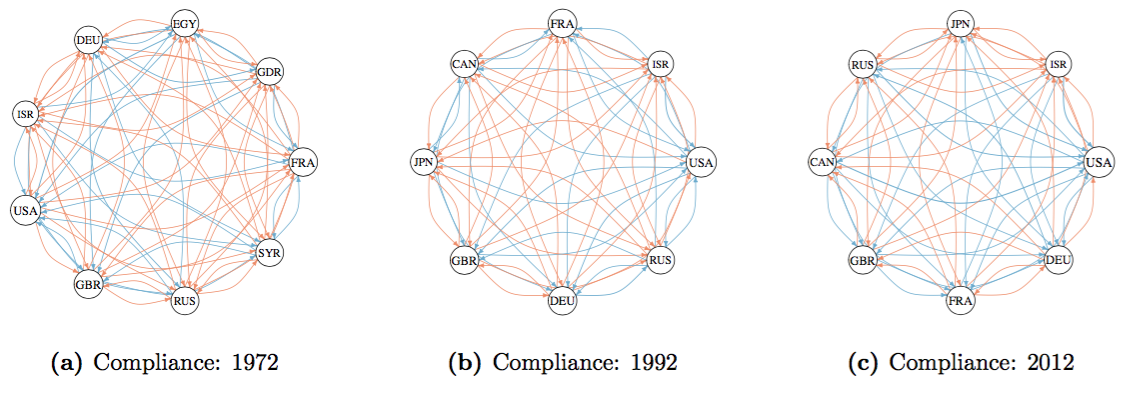
- When Do States Say Uncle? Network Dependence and Sanction Compliance – with Cassy Dorff (2017). International Interactions.
-
In this article we address the long-debated question of when and why states comply with sanctions. While the literature remains indeterminate as to whether the key mechanisms driving sanction compliance are tied to interstate relations, intrastate constraints, or a dynamic combination of the two, our theoretical framework and methodological approach provide a novel perspective that incorporates insights drawn from network theory to explain the time until countries comply. Specifically, we argue that reciprocity, a concept with deep roots in both network theory and international relations, has largely been overlooked in the study of sanction compliance. Though often ignored, this concept captures an essential aspect of how cooperation is fostered in the international system, and allows us to better analyze the strategic environment underlying sanctioning behavior. Given the theoretical importance of reciprocity in understanding interstate relations, we provide an approach that integrates estimations of this type of network interdependency into extant frameworks for modeling the time until countries comply with sanctions. Our results highlight that reciprocity not only has a substantive effect in explaining the duration of sanctions, but that models excluding this concept from their specifications do notably worse in terms of their predictive performance.
-
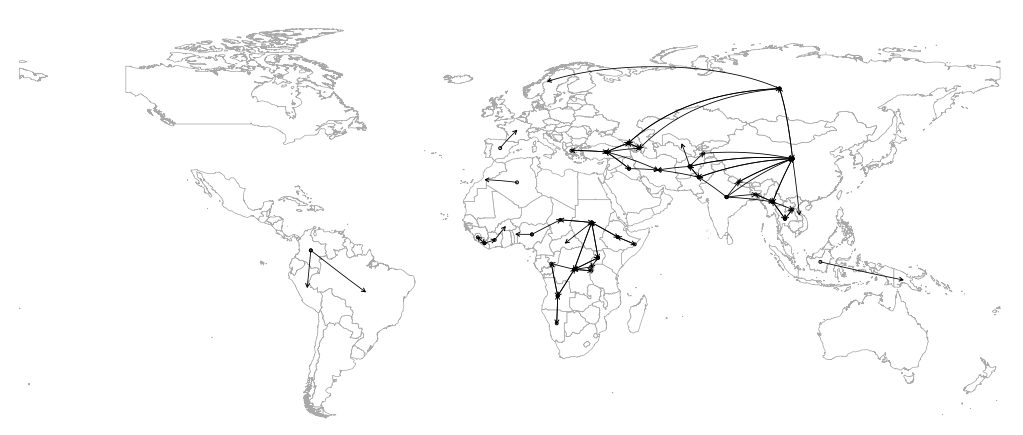
- Firewall or Wall on Fire? A Unified Framework of Conflict Contagion and the Role of Ethnic Exclusion – with Nils W. Metternich and Michael D. Ward (2017). Journal of Conflict Resolution.
-
While some borders are real firewalls against conflicts others appear like tinder just waiting for the smallest spark. Only recently has research focused on the transnational perspective of conflict and current research has focused mostly on isolated aspects of this phenomenon. In this article, we provide a unified framework for conflict contagion that takes into account receiver, sender, dyad, and network effects. This is a novel perspective on conflict contagion and our empirical results suggest that distinguishing between sender and receiver effects allows for a better understanding of spill-over effects.
-
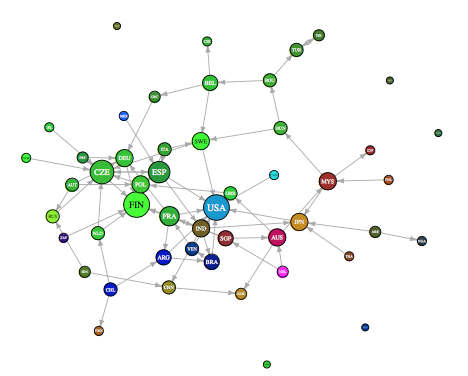
- A New Approach to Analyzing Coevolving Longitudinal Networks in International Relations – with Peter D. Hoff and Michael D. Ward (2016). Journal of Peace Research.
-
Previous models of international conflict have suffered two shortfalls. They tend not to embody dynamic changes, focusing rather on static slices of behavior over time across a single relational dimension. These models have also been empirically evaluated in ways that assumed the independence of each country, when in reality they are searching for the interdependence among all countries. A number of approaches are available now for analyzing relational data such as international conflict in a network context and a number of these can even handle longitudinal relational data, but none are developed to the point of exploring how networks can coevolve over time. We illustrate a solution to the limitations of existing approaches and apply this novel, dynamic, network based approach to study the dependencies among the ebb and flow of daily international interactions using a newly developed, and openly available, database of events among nations.
-
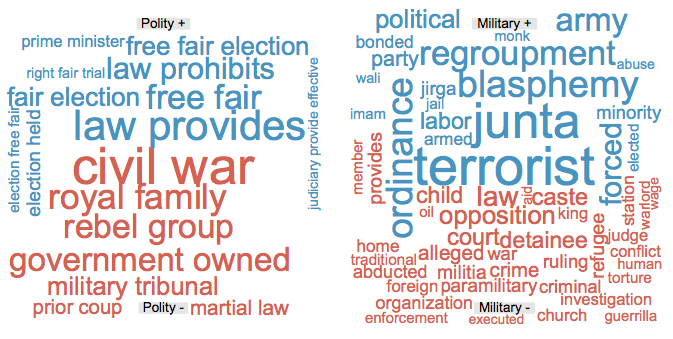
- Mining Texts to Efficiently Generate Global Data on Political Regime Types – with Jay Ulfelder and Michael D. Ward (2015). Research And Politics.
-
We describe the design and results of an experiment in using text-mining and machine-learning techniques to generate annual measures of national political regime types. Valid and reliable measures of countries’ forms of national government are essential to cross-national and dynamic analysis of many phenomena of great interest to political scientists, including civil war, interstate war, democratization, and coups d’état. Unfortunately, traditional measures of regime type are very expensive to produce, and observations for ambiguous cases are often sharply contested. In this project, we train a series of support vector machine (SVM) classifiers to infer regime type from textual data sources. To train the classifiers, we used vectorized textual reports from Freedom House and the State Department as features for a training set of prelabeled regime type data. To validate our SVM classifiers, we compare their predictions in an out-of-sample context, and the performance results across a variety of metrics (accuracy, precision, recall) are very high. The results of this project highlight the ability of these techniques to contribute to producing real-time data sources for use in political science that can also be routinely updated at much lower cost than human-coded data. To this end, we set up a text-processing pipeline that pulls updated textual data from selected sources, conducts feature extraction, and applies supervised machine learning methods to produce measures of regime type. This pipeline, written in Python, can be pulled from the Github repository associated with this project and easily extended as more data becomes available.
-
